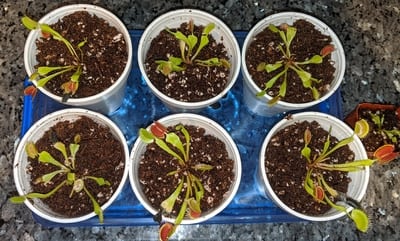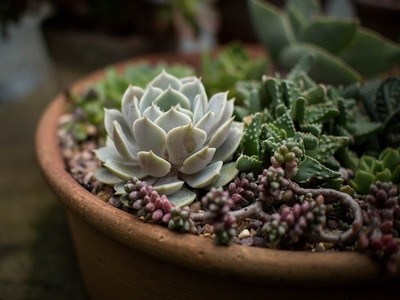Succulents and Venus flytraps are both interesting and beautiful plants to grow at home. But are they the same thing? Are Venus flytraps succulents?
Venus flytrap or Dionaea Muscipula are not a succulent. They are carnivorous plants native to South Carolina and North Carolina in the United States. Even though there might be some similarities in care between succulents and Venus flytraps, they are entirely different plants.
In this article, I will teach you the main difference between succulents and Venus flytraps. Also, I have included tips to help you grow them both.
Venus Flytraps and Succulents
Venus flytraps and succulents are very different plants. Of course, when talking about succulents, we are referring to many different species. Venus flytraps, on the other hand, are just one type of carnivorous plant.
Venus flytraps grow natively in just one small area in the United States. They grow in some counties in North Carolina and South Caroline. They grow in nutrient-poor environments with little to no access to minerals.
Venus flytraps developed their bug trapping mechanisms due to their origin. They produce most of their food through photosynthesis, but they always benefit from an extra boost. Venus flytraps capture and consume bugs to supplement their diet. They extract critical nutrients from the insects.
Venus flytraps and succulents both need plenty of sunlight. But besides that similarity, they differ greatly in their required environment.
For example, Venus flytraps need to grow in thoroughly moist environments. They tend to die if the soil ever dries up. Succulents, on the other hand, prefer dry media. Succulent start rotting if the soil stays humid for too long.
Both Venus flytraps and succulents appreciate a potting media with good drainage. However, the recommended soil composition for each varies greatly. Succulents thrive with fertilizers, while Venus flytraps prefer nutrient-free media.
Can Venus Flytraps Use Succulent Soil?
There are many different types of succulent soil. However, most soil options include some similar elements. For example, succulent soil tends to contain a significant amount of standard potting soil with additives and fertilizers.
The nutrients in succulent soil are essential for most plants. They provide key components that keep plants healthy. However, Venus flytraps have different requirements.
Succulent soil is unsuitable for Venus flytraps as it contains nutrients and fertilizers. The additives in the ground are harmful to Venus flytraps. They can cause mineral burns, weaken the plant and eventually kill it.
Planting Venus flytraps in succulent soil will cause many issues. The plant might not exhibit adverse effects right away, but it will eventually start looking down.
Succulent soil is not safe for Venus flytraps, but what about cactus soil?
Is Cactus Soil Safe for Venus Flytraps?
Sometimes cactus soil and succulent soil are referred to as the same thing. And in most cases, they are different but very similar. Both cactus soil and succulent soil are characterized by good drainage and lots of nutrients.
Cactus soil is not safe for Venus flytraps. The nutrients in cactus soil are harmful to Venus flytraps and will eventually end up killing the plant. Instead of cactus soil or succulent soil, employ carnivorous plant soil for Venus flytraps.
Luckily, succulent soil and cactus soil are not the only potting media out there. Employ carnivorous plant soil for Venus flytraps.
Carnivorous Plant Soil
Venus flytraps will end up dying if they are grown in soil with additives (minerals, fertilizers). They need nutrient-free soil with good drainage to stay healthy.
Venus flytraps thrive in carnivorous plant soil. Carnivorous plant soil does not contain any minerals and fertilizers, which are harmful to Venus flytraps. You can make carnivorous plant soil by mixing peat or long-fibered sphagnum moss with perlite or sand.
You have the option to make or buy carnivorous plant soil for your plant. You can purchase carnivorous plant soil online or in a local nursery.
If you would like to make soil for Venus flytraps, here are a few recipe examples:
- Pure peat moss
- Pure long-fibered sphagnum moss
- 4:1 or 2:1 ratio of peat moss and perlite
- 4:1 or 2:1 ratio of peat moss and silica sand
- 4:1 or 2:1 ratio of sphagnum moss and perlite
- 4:1 or 2:1 ratio of sphagnum moss and silica sand

I recommend employing an element in the soil that helps with drainage, such as sand or perlite. If you are learning about carnivorous plant soil, this article can teach you how to make it and where to buy it with specific examples and pictures: The Best Soil Options for Venus Flytraps.
Can Venus Flytraps Grow With Succulents?
Venus flytraps and succulents are both interesting plants to own. You can grow both in your home. However, how you care for them and where you plant them is critical.
In the Same Pot
Growing Venus flytraps and succulents in the same pot might be tempting. But, it is not a good idea.
Venus flytraps and succulents should not grow in the same container. Each plant needs different potting media. Also, Venus flytraps require moist potting media at all times. The excessive moisture in the soil will kill succulents.
If you want to get some companion plants for your Venus flytraps, stay away from succulents. Instead, try with these options:
- Drosera / Sundew
- Sarracenia
- Live moss
- Other Venus flytrap cultivars
Individual Pots
Growing Venus flytraps and succulents can be an enjoyable and rewarding experience. If you plan on growing both, keep them separate. Also, make sure to remember that each plant has very different requirements.
It is possible to grow Venus flytraps and succulents in the same location, as long as they are planted in individual pots.
Each plants needs different soil: carnivorous plant soil for Venus flytraps and succulent soil for your succulents.
Venus Flytrap And Succulent Care Information
Venus flytraps and succulent have very different care requirements. This section will help you provide a suitable environment for both.
Lighting: Venus flytraps and succulents need plenty of sun to stay healthy. Some succulents have lower light requirements than others, but generally, they tend to prefer sunny locations.
Venus flytraps need lots of sunlight. They start to weaken and look droopy if they do not receive at least 6 hours of direct sunlight. Optimally, they should receive 12+ hours of daily light exposure.
Watering: Water Venus flytraps and succulents at two completely different levels.
Venus flytraps must be watered often enough, so the soil never dries out completely. They do not need to be flooded with water every day, but the potting media must remain moist.
You should not water Venus flytraps with tap water or bottled water. Venus flytraps need pure water, such as distilled water, rainwater, or ro water.
Succulents do not need pure water. Standard tap water works fine for them. Also, they prefer dry media. Water the succulent once, and then skip watering until the soil is arid. For succulents, underwatering is safer than overwatering.
Soil: Venus flytraps need nutrient-free potting media: carnivorous plant soil.
Succulents are flexible in potting media. The recommended media varies depending on the species, but standard succulent soil or cactus soil is usually a good fit.
Humidity: Venus flytraps prefer high humidity environments, similar to their native ecosystem. Still, Venus flytraps can adapt to a wide variety of climates, including arid deserts.
I grow carnivorous plants in Arizona, which is dry all year long. My Venus flytraps take a few weeks to adapt to the weather, but after the acclimation process, they do just fine.
A humidifier can be beneficial for Venus flytraps, but it is not required.
Never employ a humidifier for succulents. They prefer dry climates.
Outdoor vs indoor growing: Both Venus flytraps and succulents can be grown indoors or outdoors.
If you decide to grow your plants indoors, make sure they will have enough access to lighting.
You can grow your plants indoors and place them on a sunny windowsill or use artificial lighting. Fluorescent and LED lights both work well.
I have used this LED plant light (which costs less than $30) to grow some of my Venus flytraps. That light is enough to keep them healthy.
I think this resource can save you a lot of time for carnivorous plant care research. This guide contains all you need to know to grow Venus flytraps: Ultimate Venus Flytrap Care Guide. It includes a free care sheet you can download and detailed explanations with pictures.


